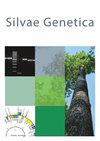Genetic structure of ural populations of Larix sibirica Ledeb. on the base of analysis of nucleotide polymorphism
IF 1
4区 农林科学
Q3 FORESTRY
引用次数: 3
Abstract
Abstract Research on the state and dynamics of the gene pool (an important natural resource that determines the potential fitness of living organisms and, ultimately, their long-term survival) becomes an important problem in the context of increased anthropogenic environmental impact. They are especially important for key species of ecosystems of a global scale importance. Larix sibirica Ledeb., which spreads from the Western Siberia to the Russian North-West, is one of such forest tree species. We identified patterns of genetic structure of populations on the example of the species’ Western race on the Middle and Northern Urals. The analysis of nucleotide polymorphism of genes of ABA-inducible protein, MADS-box-transcription factor and of 4-kumarat: CoA ligase (a part of the gene) was used as a method. Evidences were obtained that a part of the populations previously formed a single large population. At the same time, populations with different gene pools were found. As a result, differences between populations within the region were more pronounced (fixation index FST = -0.021 – 0.260, total haplotype diversity Hd = 0.636 – 0.911; nucleotide diversity π = 0.005 – 0.009; number of mutations θW = 0.005 – 0.012) than in other parts of the race. Causes of this phenomenon are discussed. It was concluded that the larch forests with a unique gene pool and/or high genetic diversity should be objects of population-oriented forestry and conservation.西伯利亚落叶松天然居群的遗传结构。在核苷酸多态性分析的基础上
基因库是决定生物潜在适应度并最终决定其长期生存的重要自然资源,在人为环境影响日益严重的背景下,基因库的状态和动态研究成为一个重要问题。它们对全球范围内重要的生态系统的关键物种尤其重要。西伯利亚落叶松从西伯利亚西部蔓延到俄罗斯西北部,就是这样一种森林树种。我们以乌拉尔中部和北部的西部人种为例,确定了种群的遗传结构模式。以aba诱导蛋白、mads盒转录因子和4-库马拉:辅酶a连接酶(部分基因)基因的核苷酸多态性分析为方法。获得的证据表明,一部分种群以前形成了一个单一的大种群。同时,还发现了具有不同基因库的种群。结果表明,区域内居群间差异明显(固定指数FST = -0.021 ~ 0.260,总单倍型多样性Hd = 0.636 ~ 0.911;核苷酸多样性π = 0.005 - 0.009;突变数(θW = 0.005 - 0.012)比其他人种多。讨论了造成这种现象的原因。结论认为,具有独特基因库和遗传多样性的落叶松林应成为人口导向林业和保护的对象。
本文章由计算机程序翻译,如有差异,请以英文原文为准。
求助全文
约1分钟内获得全文
求助全文
来源期刊

Silvae Genetica
农林科学-林学
CiteScore
2.20
自引率
10.00%
发文量
10
审稿时长
3 months
期刊介绍:
Silvae Genetica is an international peer reviewed journal with more than 65 year tradition and experience in all fields of theoretical and applied Forest Genetics and Tree breeding. It continues "Zeitschrift für Forstgenetik und Forstpflanzenzüchtung" (Journal of Forest Genetics and Forest Tree Breeding) founded by W. LANGNER in 1951.
 求助内容:
求助内容: 应助结果提醒方式:
应助结果提醒方式:


